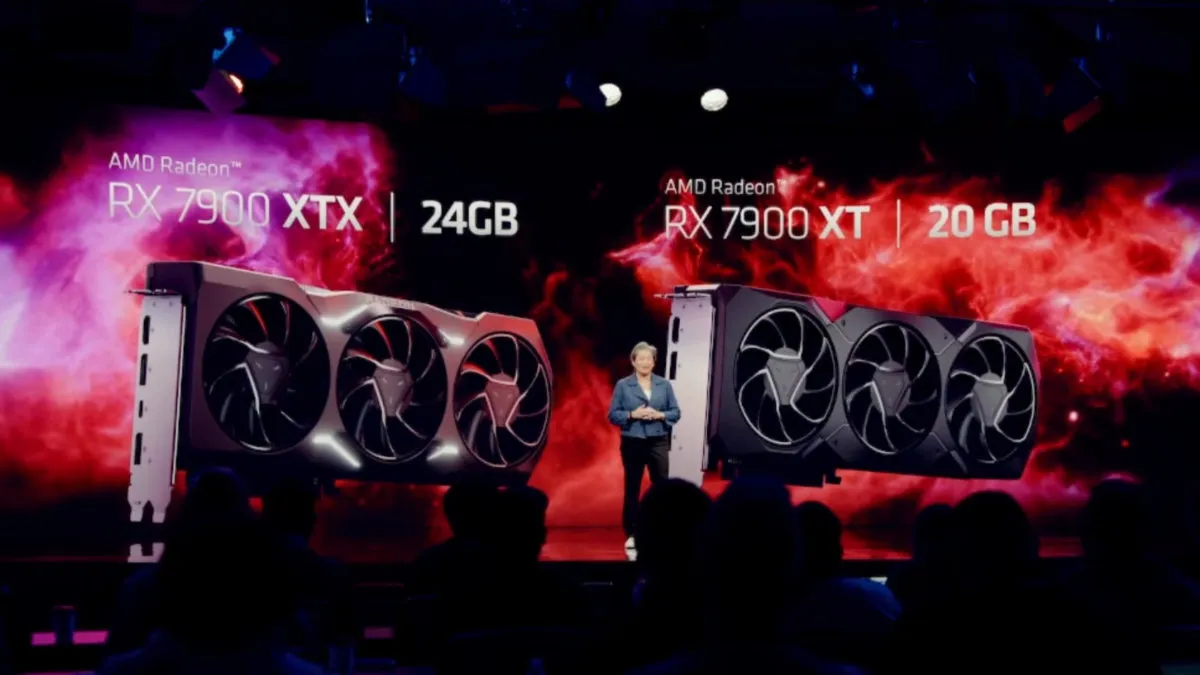AMD revealed its Radeon RX 7000 Series today in an online event which covered everything from specs to general performance and features. Team Red introduced two models to begin the launch, which were unsurprisingly the high-end contenders to up against Nvidia’s RTX 40 Series. The Radeon RX 7900 XT and 7900 XTX launch on December 13, and AMD has some lean and mean pricing to talk about.
The Radeon RX 7900 XT features an MSRP of $899 USD, and the flagship 7900 XTX is just an extra Benjamin at $999 USD. AMD advertises up to 1.7x gaming performance over the existing 6950 XT, which is nearly in line with what Nvidia just brought to the table with the $1,599 USD RTX 4090.
RDNA 3 chiplet GPUs incoming
AMD had a lot of technical info to get through. If you’re interested in every single detail, your best bet is to watch the full showcase for yourself. What gamers undoubtedly want to know is how the gaming performance will be, what the specs are for the announced models, and the additional features.
The specs for the AMD Radeon RX 7900 XTX and 7900 XT are as follows:
| RX 7900 XTX | RX 7900 XT | |
| GPU name | Navi 31 | Navi 31 |
| Process node | 5nm GCD, 6nm MCD | 5nm GCD, 6nm MCD |
| Transistors | 58 billion | 58 billion |
| Stream Processors | 12,288 | 10,752 |
| TFLOPS | 56.5 | 40 |
| Game clock | 2.3GHz | 2.0GHz |
| Boost clock | 2.5GHz | 2.4GHz |
| Memory speed | 20Gbps | 20Gbps |
| Memory capacity | 24GB | 20GB |
| Memory bus | 384-bit | 320-bit |
| Infinity Cache | 96MB | 80MB |
| Effective bandwidth | 960GB/s | 800GB/s |
| Interface | PCIe 5.0 x16 | PCIe 5.0 x16 |
| Power consumption | 355W | 300W |
| Max # of displays | 4 | 4 |
| Maximum display output | 8K 165Hz | 8K 165Hz |
| Video output interface | DisplayPort 2.1 | DisplayPort 2.1 |
| MSRP | $999 USD | $899 USD |
Starting with the GPU design, you’ll notice these are each based on the Navi 31 codename which features AMD’s highly-anticipated GPU chiplets. Just like with Ryzen CPUs, the new Radeon cards now feature multiple interlinked chips that work as a single unit. It’s a first for gaming GPUs, and this affords AMD a lot of advantages in theory. It allows RDNA 3 to be more energy efficient, cheaper to mass produce, and perhaps most importantly to gamers, perform better.
A few other specs of note are the 20GB and 24GB VRAM capacities, the PCIe 5.0 x16 interface, the DisplayPort 2.1 video output, reasonable TDPs, and the dual eight-pin power connectors. These cards will hold up well over time in terms of performance and be compatible with plenty of systems. AMD also pointed out that its Radeon 7000 Series cards will physically fit into most cases.
Screaming fast gaming and better ray tracing
Just like Nvidia, AMD is now focusing on marketing its graphics cards for 4K gaming with maximum settings and ray tracing. It’s hard to approximate just how exactly AMD’s cards will fair against the RTX 4090 and RTX 4080 in head-to-head comparisons, but there are a few promising results. From what we can tell, AMD’s still behind in ray tracing performance, but traditional rendering should be impressive.
AMD also now has a few tricks of its own to eek out extra frames. These include the upcoming FSR 2.2 update, and what AMD refers to as FSR 3.0, which uses something called “Fluid Motion Frames” that sounds surprisingly similar to DLSS 3. That will unfortunately not arrive until 2023.
In another bid to match Nvidia, AMD also announced HYPR-RX, which includes one-click latency and fps optimizations. This could be an Nvidia Reflex competitor of sorts, though it also sounds like a package technology. Lastly, it’s worth taking note of Frank Azor’s comments specifically about AMD driver stability. This has been a point of concern for many gamers in the past, as AMD’s reputation did used to suffer due to driver issues. AMD’s made significant efforts in the past couple years to repair those negative perceptions, and it seems something the company was keen to convey prior to this product launch.
More info is sure to come over the next month leading up to the launch of the AMD Radeon RX 7900 XTX and 7900 XT graphics cards. Expect more performance metrics, architecture deep dives, partner design reveals, and teases.









Published: Nov 3, 2022 07:45 pm